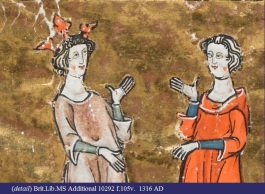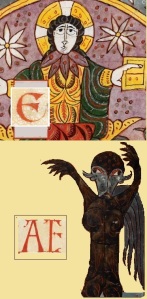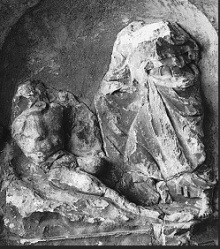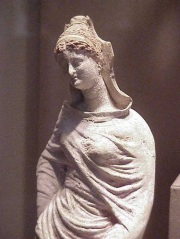![]()
“At the deepest level Isidore’s encyclopaedia is rooted in the dream that language can capture the universe and that if we but parse it correctly, it can lead us to the proper understanding of God’s creation” – Ralph Hexter
BOOK I – Grammar
– blog post links –


i 1-3 Disciplina et arte
ii 1-3 Septem Artes Liberales
iii 1-3 Litteris communis
iii 4-6 Origin of the Letters
iii 7-9 Greek Mystical Letters
iii. 10-11 Greek, Hebrew and Latin Numerals
![]()
iv. 1-2 de litteris latinis

iv. 3- 9. Phonetics – theory. {omitted}
iv. 10-11 The old Latin alphabet
iv. 12-15 ” ” ” ” (cont.)
iv. 16-18. Letters’ form, name and primal nature.
![]()

v. 1-2 Grammar – the art of speaking correctly.
NOTE: Sections v.1.3 to xix are omitted for the time being.
![]()
Marks in the Margin

 xx. 1-2a de posturis.
xx. 1-2a de posturis.
xx. 2b-4 de posituris (punctuation) – continued.
xx. 4-6a the orators’ custom.
xx. 6b the poets’ custom.
![]()
xxi. 1-2 The critic’s marks (de notis sententiarum)

xxi. 2-5 ” ” ” (cont.)
xxi. 5-7 Marks of difference and disorder.
xxi. 8-9 Paragraph markers.
xxi. 10-12 “.. difficult to discern”.
xxi. 13-20 The Diple in its varieties.
xxi. 21-23 Marks of rejection and of attention.
xxi. 23-28 Marks of the extreme.
![]()
FORMS OF ABBREVIATION
xxii. 1 Scribal abbreviations – shorthand xxii. 2 The notary’s shorthand.
Abbreviations – their history and use in Isidore’s time (reposts from Litteravisigothica.)
- (link to Litteravisigothica), ‘Medieval Abbreviations. I- Origins‘
- (link to Litteravisigothica), ‘Medieval Abbreviations’ II – Medieval period‘.
![]()

xxiii. Roman legal shorthand.
xxiv. Roman military signs (documents).
xxv. Epistolary codes (Caesar cipher).
xxvi. Roman (silent) hand- signals.
![]()
ORTHOGRAPHY

 (Preliminary) Orthographies in medieval text.
(Preliminary) Orthographies in medieval text.
” 11-12 ; 13-14 ; 15-16 ; 17-18 ;
” 19-21 ; 22 ; 23-6 ; 27-8 ; 29.
![]()
xxviii De Analogia 1-2a ; 3-4 ;

xxix Etymology 1-2a ; 2b-3a ; 3b ; 4-5 ;
xxx De glossis
xxxi. De differentiis
![]()
ERRORS & IRREGULARITIES

xxxii De barbarismo 1-2a ; 2b-5a ; 5b-9.
xxxiii De soloecismus (solecisms) 1-3 ; 2-4.
xxxiv De vitiis (faults) 1-3; 4 ; 5 ; 6-10 ; 11-13 ; 14-16.
xxxv De metaplasmus 1-2 ; 3-4 ; 5-6 ; 7 ;

xxxvi De schematibus 1-2; 3 ; 4-5 ; 6 ; 7 ; 8-9 ; 10-12; 13-14;
![]()
![]()
WORK IN PROGRESS….

Bk II – Rhetoric and dialectic
![]()

Bk III – Mathematics, music, astronomy
![]()
Bk IV – Medicine
![]()
Bk V – Laws and times
![]()
Bk VI – Books and ecclesiastical offices
![]()
Bk VII – God, angels, and saints
![]()
Bk VIII – The Church and sects
![]()
Bk IX – Languages, nations, reigns, the military, citizens, family relationships
![]()
Bk X – Vocabulary
![]()
Bk XI – The human being and portents
![]()
 Bk XII – Animals
Bk XII – Animals
![]()
Bk XIII – The cosmos and its parts
![]()
Bk XIV – The earth and its parts
![]()
Bk XV – Buildings and fields
![]()
Bk XVI – Stones and metals
![]()
Bk XVII – Rural matters
![]()
Bk XVIII – War and games
![]()
Bk XIX – Ships, buildings, and clothing
![]()
Bk XX – Provisions and various implements)
![]()
“So highly was [the Etymologies] regarded as a depository of classical learning that in a great measure, it superseded the use of the individual works of the classics themselves. Not even the Renaissance seemed to diminish the high esteem in which it was held, and according to Arévalo, it was printed ten times between 1470 and 1529. Besides these numerous reprints, the popularity of the “Etymologiae” gave rise to many inferior imitations. It furnishes abundant evidence that the writer possessed a most intimate knowledge of the Greek and Latin poets. In all, he quotes from one hundred and fifty-four authors, Christian and pagan. Many of these he had read in the originals and the others he consulted in current compilations. In style this encyclopaedic work is concise and clear and in order, admirable. Braulio, to whom Isidore sent it for correction, and to whom he dedicated it, divided it into twenty books.” – Catholic Encyclopaedia (1914)
![]()
“Modern historians, says Fontaine, have tended to overlook this interaction between the man and his Sitz-im-Leben and have therefore not fully appreciated Isidore’s works on their own terms… This present essay … is an attempt to show that Isidore, whatever the difficulties he presents to the modern historian in search of information about Visigothic Spain, does indeed have more profound purposes in writing his historical works than chronicling or presenting collections of news items from antiquity.” Paul Merritt Bassett, ‘The Use of History in the “Chronicon” of Isidore of Seville”, History and Theory, Vol. 15, No. 3 (Oct., 1976), pp. 278-292.


MANUSCRIPT COPIES OF ISIDORE’s WORKS:
Díaz y Díaz, Manuel C., (ed.), Isidoriana; colección de estudios sobre Isidoro de Sevilla (1964) pp.539-544. Includes a substantial introductory essay (in English) by Jocelyn N. Hillgarth. Index to citations; General Index; List of manuscripts.
One cannot keep up with the number of medieval manuscripts being digitised, and any list I might give today is likely to be obsolete tomorrow. If you have an afternoon to learn the different systems used by each library and region of Europe, I can recommend the DMAPP (offered by digitised medieval manuscripts.org) as a first step towards consulting the older mss.
A helpful aid to navigation of the various protocols is offered by a UCLA site – the content really ought to be downloadable as a pdf! Very helpful: http://www.utm.edu/staff/bobp/vlibrary/mdmss.shtml